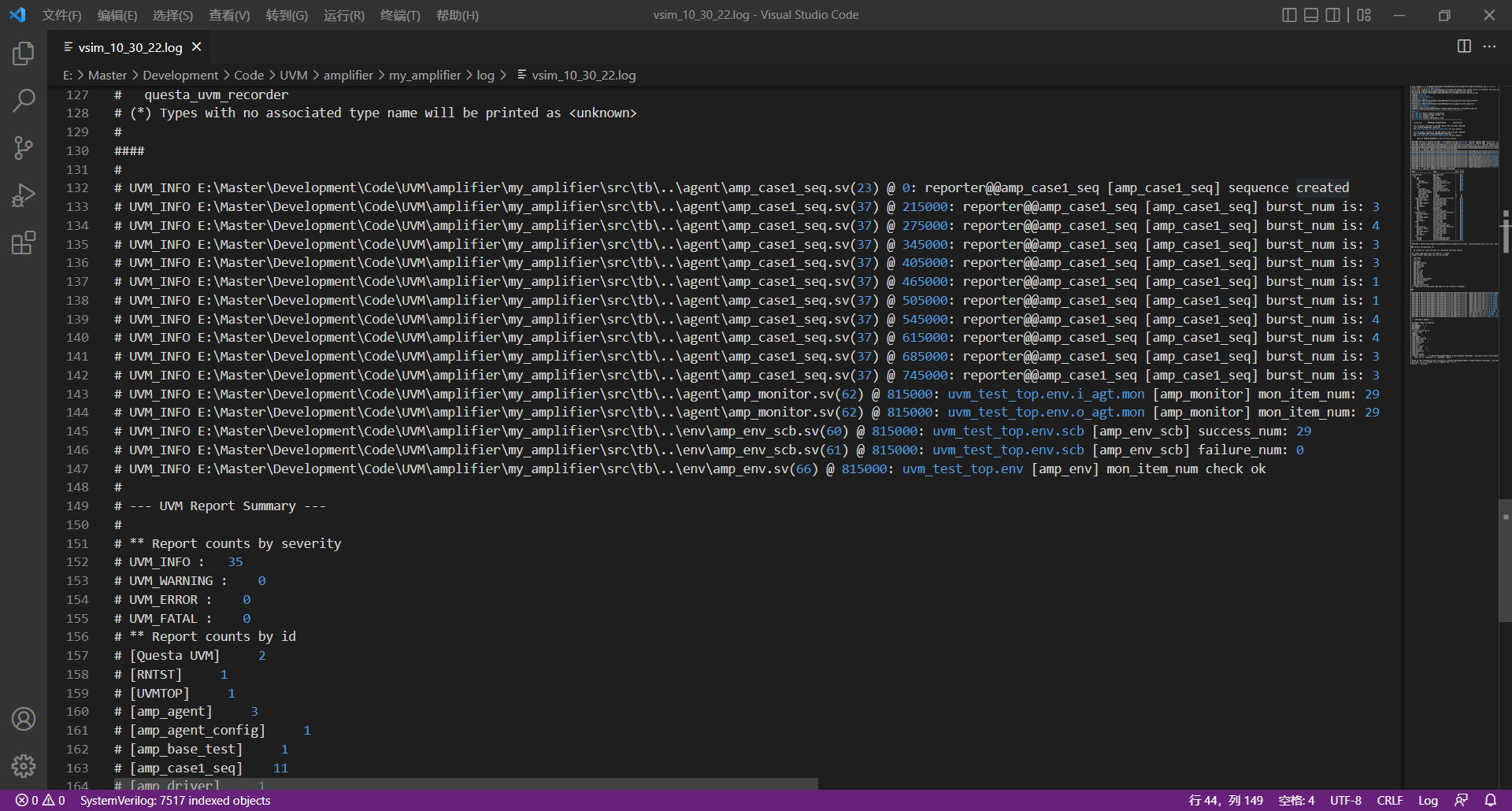一、monitor
在之前的代码中,已经成功实现了激励部分并通过了测试。换句话说,agent中的sequencer和driver已经完成,还剩下唯一一个组件:monitor。
monitor需要监控并收集总线上的数据,将其打包后发送给需要的组件。既然需要发送,自然就要用到TLM端口,因此需要创建对应的变量;需要统计获得的transaction数目,因此需要创建一个int型变量;由于有i_agt和o_agt之分,因此需要一个变量来控制monitor中的监测行为,因为输入端和输出端部分所需要的数据并不完全相同。
点击查看代码
`ifndef AMP_MONITOR_SV
`define AMP_MONITOR_SV
class amp_monitor extends uvm_monitor;
`uvm_component_utils(amp_monitor)
int mon_item_num;
bit mon_input = 0; // defualt: monitor belongs to output agent
amp_seq_item t;
virtual amp_interface vif = null;
uvm_analysis_port #(amp_seq_item) ap;
extern function new(string name = "amp_monitor", uvm_component parent = null);
extern function void build_phase(uvm_phase phase);
extern task main_phase(uvm_phase phase);
extern function void report_phase(uvm_phase phase);
extern protected task collect_item(amp_seq_item t);
endclass : amp_monitor
function amp_monitor::new(string name = "amp_monitor", uvm_component parent = null);
super.new(name, parent);
`uvm_info(get_type_name(), "created", UVM_LOW)
endfunction : new
function void amp_monitor::build_phase(uvm_phase phase);
super.build_phase(phase);
ap = new("ap", this);
mon_item_num = 0;
endfunction : build_phase
task amp_monitor::main_phase(uvm_phase phase);
super.main_phase(phase);
forever begin
@vif.ck_mon;
t = amp_seq_item::type_id::create("t");
this.collect_item(t);
`uvm_info(get_type_name(), {"collect item t:\n", t.sprint()}, UVM_FULL)
if(mon_input && t.ttype == amp_seq_item::SET_BASE_NUMBER) begin
mon_item_num += 1;
ap.write(t);
`uvm_info(get_type_name(), {"i_mon catch t:\n", t.sprint()}, UVM_FULL)
end
else if(t.rd_valid) begin
mon_item_num += 1;
ap.write(t);
`uvm_info(get_type_name(), {"o_mon catch t:\n", t.sprint()}, UVM_FULL)
end
end
endtask : main_phase
function void amp_monitor::report_phase(uvm_phase phase);
super.report_phase(phase);
`uvm_info(get_type_name(), $sformatf("mon_item_num: %0d", mon_item_num), UVM_LOW)
endfunction : report_phase
task amp_monitor::collect_item(amp_seq_item t);
if(mon_input) begin // i_agt
// set scaler
if(vif.ck_mon.wr_en_i && vif.ck_mon.set_scaler_i) begin
t.ttype = amp_seq_item::SET_SCALER;
t.no = 0;
t.base_number = 0;
t.scaler = vif.ck_mon.wr_data_i;
t.rd_scaler = vif.ck_mon.scaler_o;
end
// set base number
else if(vif.ck_mon.wr_en_i && !vif.ck_mon.set_scaler_i) begin
t.ttype = amp_seq_item::SET_BASE_NUMBER;
t.no = vif.ck_mon.wr_data_i[15:8];
t.base_number = vif.ck_mon.wr_data_i[7:0];
t.rd_scaler = vif.ck_mon.scaler_o;
end
// idle
else begin
t.ttype = amp_seq_item::IDLE;
end
end
else begin // o_agt
t.rd_valid = vif.ck_mon.rd_val_o;
t.no = vif.ck_mon.rd_data_o[31:24];
t.rd_data = vif.ck_mon.rd_data_o[23:0];
end
endtask : collect_item
`endif // AMP_MONITOR_SV
当然,由于新增了一个控制变量,因此amp_agent.sv中的代码也需要做出对应的修改,主要是根据is_active的值对mon_input的值进行修改:
点击查看代码
if(is_active == UVM_ACTIVE) begin
sqr = amp_sequencer::type_id::create("sqr", this);
drv = amp_driver::type_id::create("drv", this);
drv.vif = vif;
mon.mon_input = 1;
end
monitor内部的代码编写也常常和端口以及时序有关。因此对每一个DUT,充分了解其工作时序和端口情况是验证工作顺利展开的前提之一。
二、reference model
在这里,先不做过多处理,因为调用DPI接口是一个相对来说不熟悉的过程,因此main_phase()中使用从输入端处的monitor获取的transaction,直接计算出放大后的结果,再将transaction转发给scoreboard。
点击查看代码
`ifndef AMP_ENV_REFM_SV
`define AMP_ENV_REFM_SV
class amp_env_refm extends uvm_component;
`uvm_component_utils(amp_env_refm)
uvm_blocking_get_port #(amp_seq_item) gp;
uvm_analysis_port #(amp_seq_item) ap;
amp_seq_item t;
amp_seq_item scb_t;
int res;
extern function new(string name = "amp_env_refm", uvm_component parent = null);
extern function void build_phase(uvm_phase phase);
extern task main_phase(uvm_phase phase);
endclass : amp_env_refm
function amp_env_refm::new(string name = "amp_env_refm", uvm_component parent = null);
super.new(name, parent);
`uvm_info(get_type_name(), "created", UVM_LOW)
endfunction : new
function void amp_env_refm::build_phase(uvm_phase phase);
super.build_phase(phase);
gp = new("gp", this);
ap = new("ap", this);
endfunction : build_phase
task amp_env_refm::main_phase(uvm_phase phase);
super.main_phase(phase);
while(1) begin
t = new("t");
scb_t = new("scb_t");
gp.get(t);
scb_t.copy(t);
res = t.base_number*t.rd_scaler;
scb_t.rd_data = res;
ap.write(scb_t);
end
endtask : main_phase
`endif // AMP_ENV_REFM_SV
三、scoreboard
计分板(scoreboard)的功能也比较单一:分别拿到从reference model和从DUT输出的数据,进行比较。数据都从FIFO中获取。
点击查看代码
`ifndef AMP_ENV_SCB_SV
`define AMP_ENV_SCB_SV
class amp_env_scb extends uvm_scoreboard;
`uvm_component_utils(amp_env_scb);
uvm_blocking_get_port #(amp_seq_item) exp_gp;
uvm_blocking_get_port #(amp_seq_item) act_gp;
amp_seq_item exp_t, act_t;
int success_num, failure_num;
extern function new(string name = "amp_env_scb", uvm_component parent = null);
extern function void build_phase(uvm_phase phase);
extern task main_phase(uvm_phase phase);
extern function void report_phase(uvm_phase phase);
endclass : amp_env_scb
function amp_env_scb::new(string name = "amp_env_scb", uvm_component parent = null);
super.new(name, parent);
`uvm_info(get_type_name(), "created", UVM_LOW)
endfunction : new
function void amp_env_scb::build_phase(uvm_phase phase);
super.build_phase(phase);
exp_gp = new("exp_gp", this);
act_gp = new("act_gp", this);
success_num = 0;
failure_num = 0;
endfunction : build_phase
task amp_env_scb::main_phase(uvm_phase phase);
super.main_phase(phase);
while(1) begin
exp_gp.get(exp_t);
act_gp.get(act_t);
if(exp_t.no != act_t.no)
`uvm_info(get_type_name(), $sformatf("no is different, exp_t.no: %0d, act_t.no: %0d", exp_t.no, act_t.no), UVM_LOW)
else begin
if(exp_t.rd_data == act_t.rd_data)
success_num += 1;
else begin
failure_num += 1;
`uvm_info(get_type_name(), $sformatf("exp_t: scaler: %0d, base_number: %0d, exp_res: %0d", exp_t.rd_scaler, exp_t.base_number, exp_t.rd_data), UVM_LOW)
`uvm_info(get_type_name(), $sformatf("act_t: scaler: %0d, base_number: %0d, act_res: %0d", act_t.rd_scaler, act_t.base_number, act_t.rd_data), UVM_LOW)
`uvm_error("SCORE ERROR", "actual rd_data is not equal with expect rd_data")
end
end
end
endtask : main_phase
function void amp_env_scb::report_phase(uvm_phase phase);
super.report_phase(phase);
`uvm_info(get_type_name(), $sformatf("success_num: %0d", success_num), UVM_LOW)
`uvm_info(get_type_name(), $sformatf("failure_num: %0d", failure_num), UVM_LOW)
endfunction : report_phase
`endif // AMP_ENV_SCB_SV
当然,在最后的report_phase()中,会输出比较结果,可以使用该结果与monitor中report_phase()的输出结果进行比对,实现简单的debug。
四、FIFO的创建和连接
从验证结构和上述的代码中,已经默认使用到了FIFO,不然不会定义那么多TLM端口。
作为与env内部组件之间的通信的一部分,FIFO自然需要在env下进行创建和连接。根据验证结构,env中需要三个FIFO。在amp_env.sv中新增三个uvm_tlm_analysis_fifo型成员变量,例化后在connect_phase()中完成连接。
点击查看代码
`ifndef AMP_ENV_SV
`define AMP_ENV_SV
class amp_env extends uvm_env;
`uvm_component_utils(amp_env)
amp_agent_config agt_cfg;
amp_env_refm refm;
amp_env_scb scb;
amp_agent i_agt;
amp_agent o_agt;
uvm_tlm_analysis_fifo #(amp_seq_item) iagt_refm_fifo;
uvm_tlm_analysis_fifo #(amp_seq_item) oagt_scb_fifo;
uvm_tlm_analysis_fifo #(amp_seq_item) refm_scb_fifo;
extern function new(string name = "amp_env", uvm_component parent = null);
extern function void build_phase(uvm_phase phase);
extern function void connect_phase(uvm_phase phase);
extern function void report_phase(uvm_phase phase);
endclass : amp_env
function amp_env::new(string name = "amp_env", uvm_component parent = null);
super.new(name, parent);
`uvm_info(get_type_name(), "created", UVM_LOW)
endfunction : new
function void amp_env::build_phase(uvm_phase phase);
super.build_phase(phase);
if(!uvm_config_db #(amp_agent_config)::get(this, "", "agt_cfg", agt_cfg))
`uvm_error("NO CONFIG", $sformatf("No config for: %s. Check tests", get_full_name()))
refm = amp_env_refm::type_id::create("refm", this);
scb = amp_env_scb::type_id::create("scb", this);
i_agt = amp_agent::type_id::create("i_agt", this);
i_agt.is_active = agt_cfg.i_agt_is_active;
o_agt = amp_agent::type_id::create("o_agt", this);
o_agt.is_active = agt_cfg.o_agt_is_active;
iagt_refm_fifo = new("iagt_refm_fifo", this);
oagt_scb_fifo = new("oagt_scb_fifo", this);
refm_scb_fifo = new("refm_scb_fifo", this);
endfunction : build_phase
function void amp_env::connect_phase(uvm_phase phase);
super.connect_phase(phase);
i_agt.mon.ap.connect(iagt_refm_fifo.analysis_export);
refm.gp.connect(iagt_refm_fifo.blocking_get_export);
o_agt.mon.ap.connect(oagt_scb_fifo.analysis_export);
scb.act_gp.connect(oagt_scb_fifo.blocking_get_export);
refm.ap.connect(refm_scb_fifo.analysis_export);
scb.exp_gp.connect(refm_scb_fifo.blocking_get_export);
endfunction : connect_phase
function void amp_env::report_phase(uvm_phase phase);
super.report_phase(phase);
if(i_agt.mon.mon_item_num == o_agt.mon.mon_item_num)
`uvm_info(get_type_name(), "mon_item_num check ok", UVM_LOW)
else
`uvm_error("ENV ERROR", "mon_item_num check error")
endfunction : report_phase
`endif // AMP_ENV_SV
FIFO的连接其实就是“看人下菜碟”:根据自己的需要选择FIFO上对应的端口即可。这一点无论是对FIFO,还是对之前组件中用到的TLM来说都是一样的。
在env中,使用到了report_phase(),该phase在这里的主要作用是比对i_agt和o_agt各自处理的transaction数目。一般来说,这两者应当相等。如果不相等,则可能出现了逻辑错误等问题。
在env中进行比较是因为这两个值分别在不同的monitor中。作为上层组件的env,自然能很方便地获取到不同agent中的信息;而在agent的不同例化:i_agt和o_agt中,两者都不能互相获取到对方的transaction处理数目。因此这一比较工作需要在env中完成。
五、运行
由于在reference model中已经计算了结果,因此最终的比较结果应该以“success”占了绝大多数。

可以看到,此次仿真中,i_agt中的monitor捕获到了29个有效transaction,o_agt中的monitor同样捕获到了29个有效transaction。事实上,这里计算burst_num的累计和,也能发现其结果等于29(3+4+3+3+1+1+4+4+3+3)。
经过scoreboard比对后发现两者transaction的计算结果相同,可以认为整个仿真环境搭建成功。
至此,整个验证平台搭建完成,之后会在Linux上进行优化。
本文来自博客园,作者:TooyamaYuuouji,转载请注明原文链接:https://www.cnblogs.com/Lexington-CV2/articles/16651117.html




 浙公网安备 33010602011771号
浙公网安备 33010602011771号